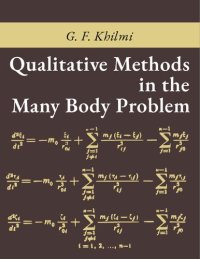
Ebook: Qualitative Methods In The Many Body Problem
Author: G. F. Khilmi
- Year: 1961
- Publisher: Gordon & Breach
- Language: English
- pdf
The n-body problem is the name usually given to the problem of the motion of a system of many particles attracting each other according to Newton’s law of gravitation. This is the classical problem of mathematical natural science, the significance of which goes far beyond the limits of its astronomical applications.
The n-body problem has been the main topic of celestial mechanics from the time of its inception as a science. Now that many of the problems of celestial mechanics have become part of geophysics, the central position of the w-body problem has been further strengthened.
The fundamental dynamical problem for a system of n gravitating bodies is the investigation and predetermination of the changes in position and velocity that the particles undergo as the time varies. However, this is a very complex non-linear problem whose solution has not been possible under the present-day status of mathematical analysis.
In the first chapter, we give the equations and general integrals of the n-body problem, and we study the simplest theorems on the final motion due to Jacobi.
In the second chapter, we consider means of applying the method of dimensional analysis to the n-body problem. As far as we know, dimensional analysis has not been used before in the investigation of the final motion; though it does not yield definitive results in this area, it is very use ful in carrying out a preliminary analysis of the problem.
In the third chapter, we present our “method of continuous induction'' and we consider some applications of it in which the final motion in the n-body problem is analyzed. This method allows us to obtain effective qualitative results, namely, it allows us to formulate sufficient conditions for the occurrence of certain types of final motions in the form of conditions on the initial state of the dynamical system.
The fourth chapter is devoted to the method of invariant measure. The application of this method to the many-body problem has necessitated working out a number of theorems on the measure theory of dynamical systems. These are presented at the beginning of the chapter. At the end of the chapter, we prove some very general theorems on the motion of a system of gravitating bodies using the method of invariant measure.
In the fifth chapter, an attempt is made to analyze some cases of the evolution of a system of n gravitating bodies on the basis of celestial mechanics. Here, we shall be concerned with the processes which are of cosmogonical interest, and which are accompanied by the conversion of mechanical energy into non-mechanical forms.
The n-body problem has been the main topic of celestial mechanics from the time of its inception as a science. Now that many of the problems of celestial mechanics have become part of geophysics, the central position of the w-body problem has been further strengthened.
The fundamental dynamical problem for a system of n gravitating bodies is the investigation and predetermination of the changes in position and velocity that the particles undergo as the time varies. However, this is a very complex non-linear problem whose solution has not been possible under the present-day status of mathematical analysis.
In the first chapter, we give the equations and general integrals of the n-body problem, and we study the simplest theorems on the final motion due to Jacobi.
In the second chapter, we consider means of applying the method of dimensional analysis to the n-body problem. As far as we know, dimensional analysis has not been used before in the investigation of the final motion; though it does not yield definitive results in this area, it is very use ful in carrying out a preliminary analysis of the problem.
In the third chapter, we present our “method of continuous induction'' and we consider some applications of it in which the final motion in the n-body problem is analyzed. This method allows us to obtain effective qualitative results, namely, it allows us to formulate sufficient conditions for the occurrence of certain types of final motions in the form of conditions on the initial state of the dynamical system.
The fourth chapter is devoted to the method of invariant measure. The application of this method to the many-body problem has necessitated working out a number of theorems on the measure theory of dynamical systems. These are presented at the beginning of the chapter. At the end of the chapter, we prove some very general theorems on the motion of a system of gravitating bodies using the method of invariant measure.
In the fifth chapter, an attempt is made to analyze some cases of the evolution of a system of n gravitating bodies on the basis of celestial mechanics. Here, we shall be concerned with the processes which are of cosmogonical interest, and which are accompanied by the conversion of mechanical energy into non-mechanical forms.
Download the book Qualitative Methods In The Many Body Problem for free or read online
Continue reading on any device:

Last viewed books
Related books
{related-news}
Comments (0)